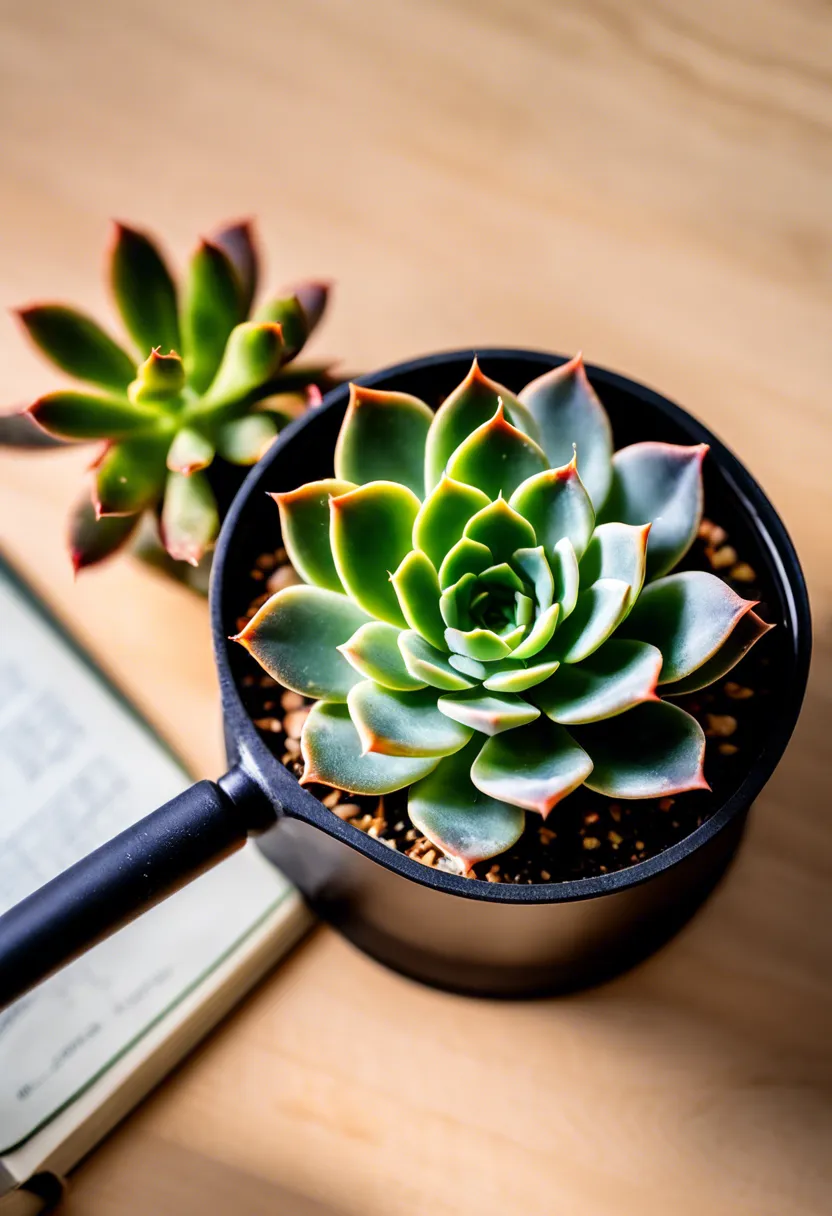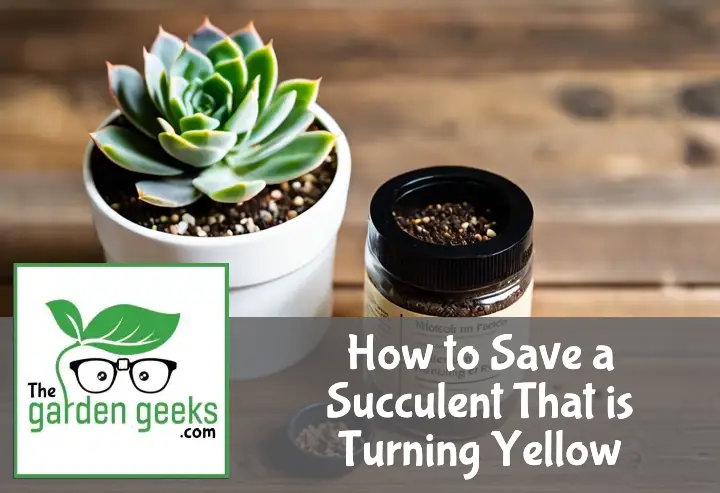Did you know that a staggering 97% of first-time succulent owners have experienced their Succulent Turning Yellow? This common issue can be a sign of various problems, from overwatering to inadequate light.
If you’re part of this majority, don’t panic! The good news is, succulents are resilient plants. With the right knowledge and care, it’s entirely possible to nurse your yellowing succulent back to health.
Keep reading about Succulent Turning Yellow and learn how to diagnose and treat this common plant problem.
Quick Answer
- Identify the cause of your succulent turning yellow, which could be overwatering, underwatering, pests or diseases.
- Diagnose your succulent’s health by looking for signs of overwatering (soft, mushy leaves) vs. underwatering (wrinkled, dry leaves).
- Revive a yellow succulent by adjusting watering habits, removing diseased parts if necessary and repotting in fresh soil.
- Prevent future issues by using proper watering techniques and providing ideal lighting and temperature conditions.

Why is My Succulent Turning Yellow?
Common Causes of Yellowing
When your succulent starts looking more yellow than green, it’s screaming for help. One big villain here is overwatering. Succulents are like camels; they store water and prefer a dry desert over a wet swamp. So, when you give them too much water, their roots can rot, making the leaves turn yellow.
Another culprit could be poor soil quality. These plants need well-draining soil to thrive. If the soil holds too much water, it’s bad news for your plant buddy.
Lastly, don’t forget about succulent diseases and pests. They can sneak up on your plant and cause damage, leading to that sad yellow color.
Impact of Environmental Factors
Succulents love the sun but not too much of it. Not enough light can make them stretch out and fade to yellow. On the flip side, too much direct sunlight can scorch their leaves, also causing yellowing.
Temperature swings are another no-no. These plants enjoy stability. If it gets too cold or too hot, they might protest by turning yellow.
Humidity is tricky. While succulents can handle dry air like champs, high humidity levels can stress them out, leading to—you guessed it—yellow leaves.
So there you have it! Keep an eye on these factors to keep your succulent happy and green (not yellow).
How to Diagnose Your Succulent’s Health
Knowing if your succulent is happy or crying for help is key. Spotting the difference between overwatered succulents and those thirsty for a drink, plus catching any bug bullies early, can save your green buddy.
Signs of Overwatering vs. Underwatering
When your succulent feels too squishy or looks like it’s melting, that’s a cry from being too wet. Overwatered succulents symptoms include leaves falling off with just a gentle poke. It’s like they’re drowning in all that water you gave them!
On the flip side, an underwatered succulent starts looking wrinkly and shriveled. Think of it as the plant version of being super thirsty on a hot day. Their leaves might also feel dry and crispy to the touch.
Getting watering right is more art than science. Too much love in the form of water can lead to root rot, while not enough makes them go all raisin-like. The trick is finding that sweet spot where your succulent feels just right.
Identifying Pests and Diseases
No one likes uninvited guests, especially your succulents! Common pests in succulents include mealybugs hiding in cozy leaf corners and spider mites treating your plant like an all-you-can-eat buffet.
Seeing tiny bugs or webbing? You’ve got company. These pests suck the life out of plants, leaving them weak and yellowed. But don’t panic! Catching these critters early means you can kick them out before they do serious damage.
Identifying diseases in succulents often starts with spotting weird spots or growths on leaves. Fungal infections love to crash the party when conditions are too damp. If your plant’s leaves start looking spotty or mushy, it’s time to act fast.
Treating diseased plants starts with cutting away any infected parts carefully. Then, make sure they get plenty of air circulation and not too much water. Sometimes, a change in environment is all it takes to get your succulent back to health.



Step by Step: Reviving a Yellow Succulent


If your succulent has started to look more like a sad, yellow banana than a vibrant plant, don’t worry! We’re about to go through some easy steps to bring that little guy back to life. It’s like being a plant doctor, but way cooler because you get to save the day with just a few simple moves.
-
Check the soil moisture first. If it’s wetter than a sponge after a water fight, it’s too much! Overwatering is often the culprit behind yellowing leaves. Let the soil dry out completely before you even think about giving it another drink.
-
Move your succulent to a spot where it can bask in the sunlight like it’s on vacation. These plants love light, but not too much direct sun or they’ll get sunburnt (yes, plants can get sunburnt too!). A place with bright, indirect light is perfect.
-
Inspect for pests because these tiny critters can be stealthy invaders sucking the life out of your plant. Look under the leaves and near the soil for any signs of bugs or unusual spots. If you find any, gently wash them off with water and mild soap.
-
Trim off any yellow or dead leaves with clean scissors or pruning shears. This isn’t just about making your plant look pretty; it helps prevent further damage and disease spread. Think of it as removing zombie parts so the rest of the plant can thrive.
-
Adjust your watering schedule going forward. Succulents are like camels; they store water and prefer being dry over drowning in moisture. Water only when the soil is completely dry, and even then, give them just enough to quench their thirst without overdoing it.
-
Consider repotting if you suspect root rot from overwatering or if your succulent has outgrown its current home. Choose a pot with good drainage holes and use succulent-specific soil that drains well to give your plant a fresh start.
-
Give it time because patience is key when reviving any plant, especially succulents. With proper care and adjustments based on these steps, you should see improvement in color and overall health within a few weeks.
Remember, every succulent has its own personality (sort of), so what works for one might need tweaking for another. Keep an eye on your plant’s progress and adjust as needed until you’ve got that vibrant green friend back in action!
Preventative Measures for Healthy Succulents
Taking care of succulents is like a fun game. You need to know the rules to win! Let’s dive into how you can keep your leafy friends happy and healthy.
Proper Watering Techniques
Watering succulents seems easy, right? But there’s a twist. These plants hate too much water. It’s like giving them a bath when they just want a quick shower. To avoid turning your succulent yellow, think of watering as a special event. Not too often!
First off, check the soil. Is it dry? If yes, it’s showtime for watering. Give them enough water so it runs out of the pot’s bottom. This is their favorite kind of drink – thorough but not too frequent.
Timing is also key. Morning is best for watering your succulent pals. It gives them time to soak up the water before nighttime comes around. Just imagine giving them a good start to their day!
But here’s where it gets tricky: every succulent is different. Some like a drink more often than others. A good rule of thumb? Wait until the soil is dry, then give them a good soak.
Remember, overwatering is the enemy here. It’s better to be on the side of too little than too much water. Your succulent will thank you by staying green and vibrant, not yellow and sad.
Ideal Lighting and Temperature Conditions
Succulents love the sun but not too much! Think of them as beachgoers who enjoy the sunshine but retreat under an umbrella when it gets too hot.
Indoors or outdoors? That’s the big question. If you’re keeping your succulents inside, find a spot where they get plenty of indirect sunlight – near a window works great! But watch out; direct sunlight through glass can turn into a mini greenhouse, cooking your plant friend.
Outdoor succulents are pretty tough but still need some care. They love morning light and some afternoon shade when the sun gets mean.
Temperature-wise, these green buddies prefer it just right – not too hot or cold. Aim for temperatures between 60-80°F (15-26°C) during the day.
Seasons change and so should your care routine! In winter, pull back on watering and keep them in bright spots away from drafts.
Adjusting care with seasons keeps your succulents happy year-round! Remember, they’re part-time sunbathers who dislike extreme weather changes.


To Wrap Up
So, there you have it. If your Succulent Turning Yellow, don’t panic! It’s not a death sentence for your plant buddy.
Remember the key points: Overwatering is a common cause, so let that soil dry out. Sunlight is crucial too – not too much, not too little. And finally, check for pests!
So go on, be the best succulent parent you can be. Your green friends are counting on you!
Why is my succulent turning brown, not yellow?
This could be due to sunburn or overwatering. Succulents can get sunburned if they’re suddenly exposed to too much sunlight. Overwatering can lead to root rot, which causes browning.
What does a healthy succulent look like?
A healthy succulent typically has plump, firm leaves that are brightly colored. The color varies depending on the species – it could be green, purple, pink, red, or a combination of these.
Can a dead succulent be revived?
It depends on how far gone it is. If the roots and at least some of the leaves are still alive, there’s a chance you can save it by addressing the cause of its decline.
How often should I water my succulent?
Most succulents need watering only once every 1-2 weeks in the summer and once a month in winter. However, this may vary based on your local climate and the specific needs of your plant.
Is direct sunlight good for my succulent?
While most succulents enjoy plenty of light, not all of them can tolerate intense direct sunlight. Some prefer indirect light or partial shade.
Are coffee grounds good for succulents?
Coffee grounds can help improve soil drainage and add beneficial organic matter to the soil. However, they should be used sparingly as they can make the soil too acidic for some types of succulents.
Why are my succulent’s leaves falling off?
Overwatering is usually the culprit when leaves start falling off your succulent. It could also be due to temperature stress or shock from being moved or repotted recently.


